 |
 |
 |
 |
 |
 |
 |
 |
 |
 |
 |
 |
 |

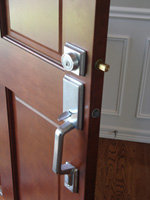 |
Entrance Door Locks - Your front entry door has a latch and deadbolt. The latch does not lock, that is the function of the deadbolt. The deadbolt is keyed to the exterior and has a lever on the interior. The key to the main entry will also lock/unlock the door that leads from your home into your garage and the man-door, which leads from your garage to the exterior. Note: Man-doors do not come on every model and in some cases may not be included due to the topography of your home site. |
| Bedroom Closets and Study Doors - These doors operate with a ball bearing surrounded by a metal sheath atop a spring on the top of each door. This snaps into a metal pocket located on the door frame. If the door opens / closes too stiffly or too loosely, you can adjust the height of the ball bearing by rotating the metal sheath. (Clockwise from top to lower it, counterclockwise to raise it). |
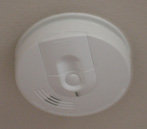 |
Smoke Detectors - Smoke detectors are located in each bedroom, the upstairs hall, one or more on the ground floor and studies equipped with doors. They are wired into your homes electrical system, but do have a battery backup if you should lose power. When the battery is losing its charge, the smoke detector will start to chirp. We recommend that you replace all the batteries in your home at least once a year (per Fire Department recommendations) as well as when chirping begins. |
 |
GFI - A GFI, or ground fault circuit interrupter, is an automatic device that provides protection against electrical shock. They are installed in the kitchen, bathrooms, laundry room, garage and outdoor outlets (anywhere there is the potential for contact between a person and an electrical appliance in or near moisture, water, or water pipes). You have two GFIs in your kitchen, which are located at the beginning of each circuit, protecting all outlets. All bathrooms will be supplied by one GFI, which will be located within one of the bathrooms (this does vary home to home). The laundry room will be supplied by one GFI, which is located within the laundry room. |
 |
Faucets - Your kitchen faucet has a retractable sprayer head. The sprayer has two settings. Periodically check to ensure the threaded fitting on the braided hose is snug and securely attached to the faucet head. If this component comes loose, water can leak into the cabinet under the sink. Your water shut-off valve for the kitchen sink hot and cold lines and dishwasher are located in the cabinet under the sink. To shut off the water to a given line, simply grasp the head and pull out. To restore the water flow, reverse the process and push the head in. |
 |
Grout - We recommend that you seal all tiled areas which have grout. This includes the master shower and tub surround, kitchen / bathroom countertops and backsplashes, bathroom floors and fireplace surrounds. Doing so will help prevent stains and help elongate the life of the grout. Please see the "Sealing Grout and Slate" document for more information. |
 |
Thermostat - Your home is equipped with one thermostat, usually located on the ground floor. The display screen indicates the time of day and current temperature. You can adjust the temperature using the up and down arrows, however if you wish to maintain a specific temperature you will need to flip the access panel down and press the "HOLD" button. For more advanced programming, please refer to the owner's manual that came with your home. You can also log onto www.NorrisHomesInc.com , and go to the Home Buyer section if you have misplaced the manual. |
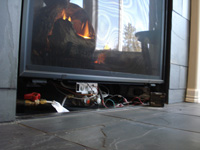 |
Fireplace Operation - There is a toggle switch, usually located to the right of your fireplace, which will ignite the fireplace. Depending on the area of which your home is located, you may have a key valve to turn off the gas supply line to the fireplace. If you do not have one you can turn off the gas by following these instructions: Make sure the fireplace is cool to touch. Remove the hood (protruding flange at top of fireplace) by pulling straight out away from fireplace face, then take off the decorative front (sometimes two pieces). Under the fireplace box, on the left side there is a red handled valve on a flexible section of pipe. Rotating the red valve will turn off the gas supply to the fireplace. Located in the bottom section, toward the center, there is a silver knob that if turned clockwise, will increase the height of the flame. Turning it counter-clockwise will reduce the height of the flame. There is a battery backup (which requires two D cell batteries) located at the bottom of the fireplace (black plastic tray) to allow the fireplace to turn on if power is out. This will enable the wall switch to ignite the fireplace. When power is restored, you will want to remove the batteries, as they will continue to be the source of power to ignite the fireplace. The glass panel in your fireplace is made of tempered glass, which resists heat, but is very susceptible to scratching. To clean the glass on the outside, use a mild cleanser, such as Windex, with a clean soft cotton cloth. On the inside, use a commercially available fireplace glass cleaner or a car polish which contains a mild abrasive, to remove any residue. Turtle Wax works great! |
| Crawl Access - Your crawl space access is located on the ground floor, typically in the coat closet or pantry. There is a vapor barrier on the ground of the crawl space. During rain storms, you may find some water accumulation. Within 48 hours of when it stops raining, all water should be absorbed into the ground. This is not an area designed to be used as storage as it is susceptible to significant humidity and temperature fluctuations. |
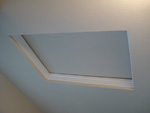 |
Attic Access - Your attic access is typically located in the master bedroom's walk-in-closet, but can be in the hall or have multiple access points. This is not an area designed to be used as storage as it is susceptible to significant humidity and temperature fluctuations. |
| Jetted Tub Access - If your home has a jetted tub in the master bathroom, you will have a panel inside your master bathroom vanity cabinet closest to the soaker tub (or in some cases in the walk-in closet). This allows access to the jetted tub's electrical wiring. When operating the jets, the water level should always be above the jets, as failure to do so can damage the components. You should never use bubble-bath while operating the jets. |
| Windows - Your home is equipped with vinyl framed windows. They are meant to operate smoothly and be maintenance free for many years. We suggest that when you open your windows, particularly the large windows, that you use two hands and grasp the frame away from the latch. If you regularly open the windows at the latch, over time you can warp the windows, so they no longer lock easily. Please keep in mind that the vinyl windows can flex and warp slightly over the course of the year as temperatures and humidity levels change sometimes making them more difficult to open, close, and latch. |
 |
Master Soaker Tub and Main Bathtub surround - These tubs are constructed of fiberglass so you should never use Comet, Ajax or other such harsh cleansers, always use liquid cleansers such as Soft Scrub. It is safe to use products like Ajax or Comet on your sinks and toilet. |
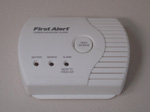 |
Carbon Monoxide Sensor - Your new home is equipped with a carbon monoxide detector. It is typically located in the upstairs hall, close to bedrooms, just below the ceiling. It is a rectangular devise that looks similar to a smoke detector. Its purpose is to warn you if dangerous carbon monoxide levels occur. Opening and closing doors and windows throughout the day, as well as the heating system using the fresh air circulation should help reduce this gas in the home if present. The sensor is powered by a battery, and we do suggest you replace the battery annually, on the same schedule as your smoke detectors. Carbon monoxide is heavier than air, therefore it is likely the lower levels of your home would have more of this gas if present. You may wish to purchase additional sensors that can be plugged into any outlet. |
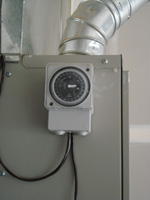 |
Fresh Air Ventilation System - This system allows you to set a schedule for bringing fresh air into your home. The controller, which is attached to the outside of your furnace, is a 24 hour dial divided into 15 minute increments. We recommend that you set it up for a minimum of four 15 minute intervals throughout the day. Please refer to the instructions on the owner's manual sheet that came with your home. Select Fresh Air Ventilation System Manual if you have misplaced the manual. |
| Water Heater - There is a gas shutoff value leading to your tank should you smell gas or if your tank needs servicing. The water heater is the only gas powered component in your house that has a pilot light. You will need to restart it if there is a disruption in your gas supply. Please refer to the instructions on the face of the tank or review the owner's manual that came with your home. Select Hot Water Tank Owner's Manual if you have misplaced the manual. |
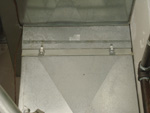 |
Filter Location - Usually located near the top of the furnace stack, the filter can be accessed by flipping two clips, then pulling the panel off using the flange as a handle. The filter should be inspected or replaced 4-6 times a year. Filters are available at most hardware stores. Although your filter has a model number to reference, the important information to know when purchasing a replacement is the dimensions and that it is a medium flow filter. |
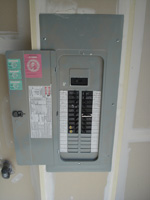 |
Electrical Panel - Located in your garage, the breakers in electrical panel are labeled according to their function. These are generalizations and may not define every area/feature in your home. As well as turning off the circuit breaker, always use a circuit tester before modifying the wiring. We encourage you to hire a qualified electriction to preform any changes to your electrical system. |
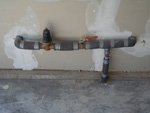 |
Water Shutoff Valve - Located in the garage, protruding from the wall, usually about 12" off the ground is a section of plumbing insulated with foam. There is a lever (usually red or yellow) that, if turned 90°, will shut off the water supply to the entire home. Normally there is a small shutoff valve near the main shutoff that will turn off the faucet outside the garage. |
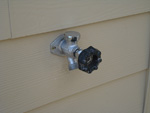 |
Hose Bibb winterization - Your home is equipped with frost-free faucets; however there are additional measures you can take to protect your exterior faucets from freezing and subsequent plumbing leaks. When temperatures drop into the freezing range, always remove any hoses from the faucet because as the water freezes in the hose it can expand into the spigot and crack it. You can further protect the faucet by purchasing and installing a protective Styrofoam cap, available at most hardware stores. If there is an extended period of freezing temperatures you can turn off the small shutoff valve near the main shutoff, and then temporarily turn on the outside faucet to drain any water in the line. When water no longer flows from the faucet turn it off. With no water in the line there should be no risk of pipes cracking. |
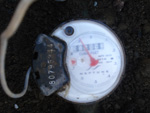 |
Water meter - The water meter is in a plastic or concrete and metal box buried near the front left or right corner of your property. It has an access hatch on the top to monitor water consumption. If you receive an excessive water bill, turn off all sources of water consumption. Let the water lines settle for 5-10 minutes. Review your water meter and to determine if you are still consuming water. You would see the numerical dial spinning or the triangle above the numerical dial rotating. If it is consuming water turn off the main water shutoff valve in the garage. Wait a few minutes then check the water meter again. If it has stopped turning then you have a leak somewhere in your house, if it has not stopped turning then you have a leak between the water meter and the water shutoff valve in the garage. In either case contact Norris Homes immediately. If you are beyond your one year warranty, contact a qualified plumber as-soon-as-possible. See the "Protect Your Home from Water Damage" document for further information regarding water leaks and damage. |
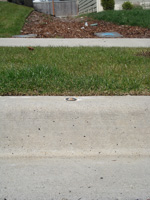 |
 |
Property Corners - The front corners of a lot are usually marked by metal pins set in the edge of the curb/sidewalk. Typically the property actually starts about 4-6" inside the sidewalk, but if you line up the pin in the sidewalk with the rear corner marker it will indicate your left and right property edges. The rear property corners are marked by metal pins with brightly colored caps. Usually there is a white stake adjacent to this marker. |
| © 2016 Norris Homes, Inc. | Site Map Disclaimer/Terms of Use | ||||